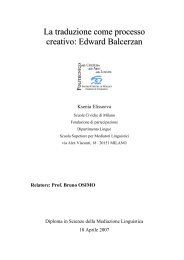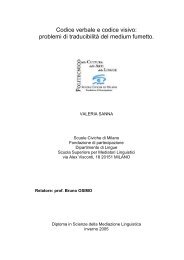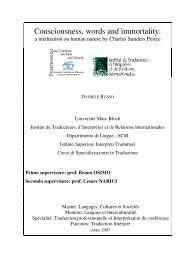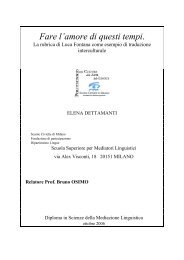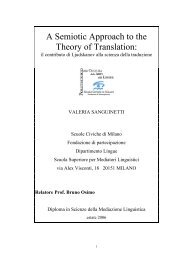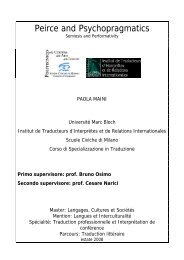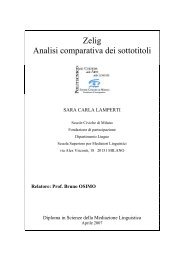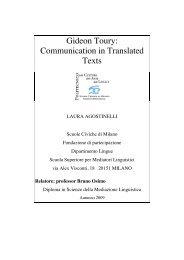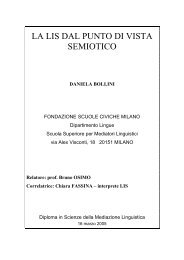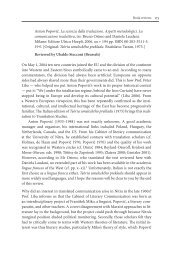Ksenia Elisseeva - Bruno Osimo, traduzioni, semiotica della ...
Ksenia Elisseeva - Bruno Osimo, traduzioni, semiotica della ...
Ksenia Elisseeva - Bruno Osimo, traduzioni, semiotica della ...
Create successful ePaper yourself
Turn your PDF publications into a flip-book with our unique Google optimized e-Paper software.
2.1 Elements.<br />
Chess<br />
Language<br />
2.1. The square. 2.1. Some nonsign background.<br />
2.1.1. A very small set of pieces, sixteen<br />
in all, of which six are different. The first<br />
significant elements are<br />
2.1.2. a finite number, however large, of<br />
moves, i.e., of three elements: initial<br />
position, new position, chess piece. The<br />
move has a very broad meaning which is<br />
realized differently each time in<br />
2.1.3. a finite number of configurations of<br />
pieces, each of which is characterized by<br />
its own traits: pawn chain, center,<br />
copula, weak point, squares of a given<br />
color, opposition, check, zugzwang, etc.<br />
The number of such traits is finite; from<br />
these configurations is formed<br />
2.1.4. an infinite set of positions: the<br />
arrangement of all the pieces on the<br />
chessboard at a given moment of time t.<br />
The positions can be divided into correct<br />
and incorrect positions; it is impossible to<br />
arrive at an incorrect position by a<br />
correct play from initial position. There is<br />
an intermediate class of positions that<br />
can only be arrived at by completely<br />
ignoring the game's principles and that<br />
are meaningless from the standpoint of<br />
the player's practice but not from that of<br />
the theoretician.<br />
2.1.1. A very small set of auxiliary<br />
morphemes: affixes, inflections,<br />
grammatical prepositions, and in<br />
generaI “empty words”.<br />
2.1.2. The first significant element is<br />
the lexical morpheme; there is a<br />
finite number, however large, of<br />
morphemes. It is still a potential<br />
meaning which is realized in the<br />
elements of<br />
2.1.3. a finite set of words, each of<br />
which is characterized by a finite<br />
set of traits (Revzin 1969: 63-74):<br />
the word's differential traits, semes,<br />
and semantic valences. From these<br />
words is formed<br />
2.1.4. an infinite set of sentences,<br />
which can be subdivided into<br />
sentences that are correct,<br />
incorrect, and an intermediate<br />
class.<br />
2.1.5. Match 2.1.5. Text<br />
2.1.6. Outcome: winning, draw, losing 2.1.6. Understanding, incomplete<br />
understanding, lack of<br />
understanding<br />
38



